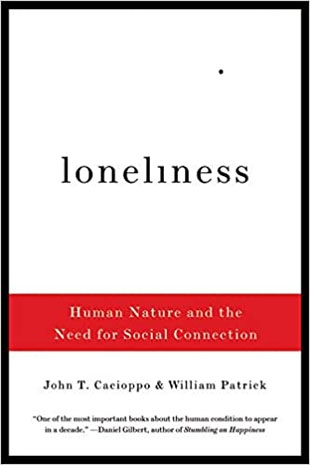Studies show that roughly 20 percent of people — 60 million in the United States alone — are feeling lonely at any given moment. We usually think of these individuals as being in physical isolation yet all of us have experienced loneliness at a party, on a subway, or eating at our table surrounded by family. Other studies have revealed that Americans today have fewer close friends than previous generations did. It has been estimated that as many as 32 million Americans live alone.
John T. Cacioppo, the Tiffany and Margaret Blake Distinguished Service Professor at the University of Chicago, is one of the founders of the new, interdisciplinary field of neuroscience which has used brain scans to examine the ways in which social isolation impacts our bodies and behavior. Along with science writer William Patrick, he presents a fascinating assessment of loneliness and the need for social connection. They share the UCLA Loneliness Scale, a list of 20 questions with no right or wrong answers which measure a person's level of loneliness.
The book is organized into three sections. In "The Lonely Heart," the authors lay out the roots of loneliness in three areas: (1) a person's individual, genetically based level of vulnerability to social disconnection; (2) a person's ability to regulate the emotions associated with feeling isolated; and (3) a person's mental representations and expectations of others. These factors combine to influence stress levels, immune response, and negative cycles of self-defeating behaviors. Cacioppo and Patrick point out that loneliness can be dealt with effectively by understanding our fears and reframing how we think about social situations. They also salute the practice of altruism as an invaluable corrective.
In the second section, "From Selfish Genes to Social Beings," they make it clear that we can move beyond the narrow confines of self-interest and ruthless competition to healthy and meaningful social interaction. The last section, "Finding Meaning in Connection," heralds the staying power of social cooperation as part of the evolutionary capacity of human beings.
The authors remind us that in 1976 novelist Kurt Vonnegut wrote a story about a pediatrician who ran for president of the United States with the slogan "Lonesome No More." He had a plan to create artificial families — designated by new, totemic middle names — thereby linking every citizen to all or of his or her brothers and sisters. Today we see people reaching out to others through clubs, book discussion groups, online social networking sites, and other forums. Cacioppo and Patrick conclude: "As individuals, and as a society, we have everything to gain, and everything to lose, in how well or how poorly we manage our need for human connection."
